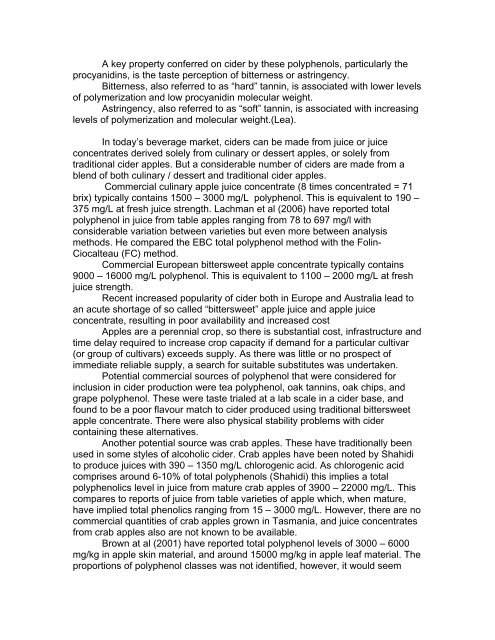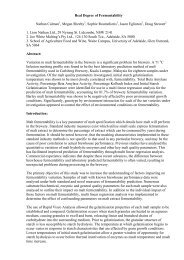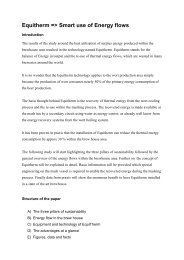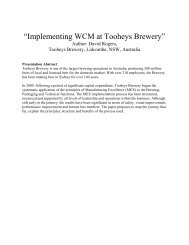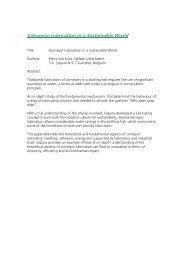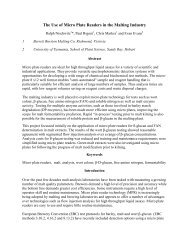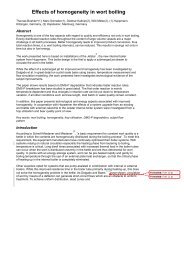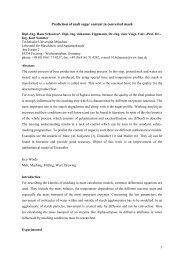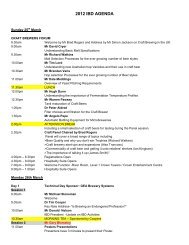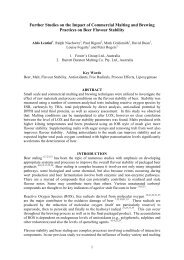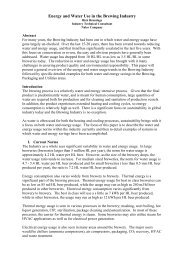Bitter Apples For Cider Making - An Alternative
Bitter Apples For Cider Making - An Alternative
Bitter Apples For Cider Making - An Alternative
You also want an ePaper? Increase the reach of your titles
YUMPU automatically turns print PDFs into web optimized ePapers that Google loves.
A key property conferred on cider by these polyphenols, particularly the<br />
procyanidins, is the taste perception of bitterness or astringency.<br />
<strong>Bitter</strong>ness, also referred to as “hard” tannin, is associated with lower levels<br />
of polymerization and low procyanidin molecular weight.<br />
Astringency, also referred to as “soft” tannin, is associated with increasing<br />
levels of polymerization and molecular weight.(Lea).<br />
In today’s beverage market, ciders can be made from juice or juice<br />
concentrates derived solely from culinary or dessert apples, or solely from<br />
traditional cider apples. But a considerable number of ciders are made from a<br />
blend of both culinary / dessert and traditional cider apples.<br />
Commercial culinary apple juice concentrate (8 times concentrated = 71<br />
brix) typically contains 1500 – 3000 mg/L polyphenol. This is equivalent to 190 –<br />
375 mg/L at fresh juice strength. Lachman et al (2006) have reported total<br />
polyphenol in juice from table apples ranging from 78 to 697 mg/l with<br />
considerable variation between varieties but even more between analysis<br />
methods. He compared the EBC total polyphenol method with the Folin-<br />
Ciocalteau (FC) method.<br />
Commercial European bittersweet apple concentrate typically contains<br />
9000 – 16000 mg/L polyphenol. This is equivalent to 1100 – 2000 mg/L at fresh<br />
juice strength.<br />
Recent increased popularity of cider both in Europe and Australia lead to<br />
an acute shortage of so called “bittersweet” apple juice and apple juice<br />
concentrate, resulting in poor availability and increased cost<br />
<strong>Apples</strong> are a perennial crop, so there is substantial cost, infrastructure and<br />
time delay required to increase crop capacity if demand for a particular cultivar<br />
(or group of cultivars) exceeds supply. As there was little or no prospect of<br />
immediate reliable supply, a search for suitable substitutes was undertaken.<br />
Potential commercial sources of polyphenol that were considered for<br />
inclusion in cider production were tea polyphenol, oak tannins, oak chips, and<br />
grape polyphenol. These were taste trialed at a lab scale in a cider base, and<br />
found to be a poor flavour match to cider produced using traditional bittersweet<br />
apple concentrate. There were also physical stability problems with cider<br />
containing these alternatives.<br />
<strong>An</strong>other potential source was crab apples. These have traditionally been<br />
used in some styles of alcoholic cider. Crab apples have been noted by Shahidi<br />
to produce juices with 390 – 1350 mg/L chlorogenic acid. As chlorogenic acid<br />
comprises around 6-10% of total polyphenols (Shahidi) this implies a total<br />
polyphenolics level in juice from mature crab apples of 3900 – 22000 mg/L. This<br />
compares to reports of juice from table varieties of apple which, when mature,<br />
have implied total phenolics ranging from 15 – 3000 mg/L. However, there are no<br />
commercial quantities of crab apples grown in Tasmania, and juice concentrates<br />
from crab apples also are not known to be available.<br />
Brown at al (2001) have reported total polyphenol levels of 3000 – 6000<br />
mg/kg in apple skin material, and around 15000 mg/kg in apple leaf material. The<br />
proportions of polyphenol classes was not identified, however, it would seem


